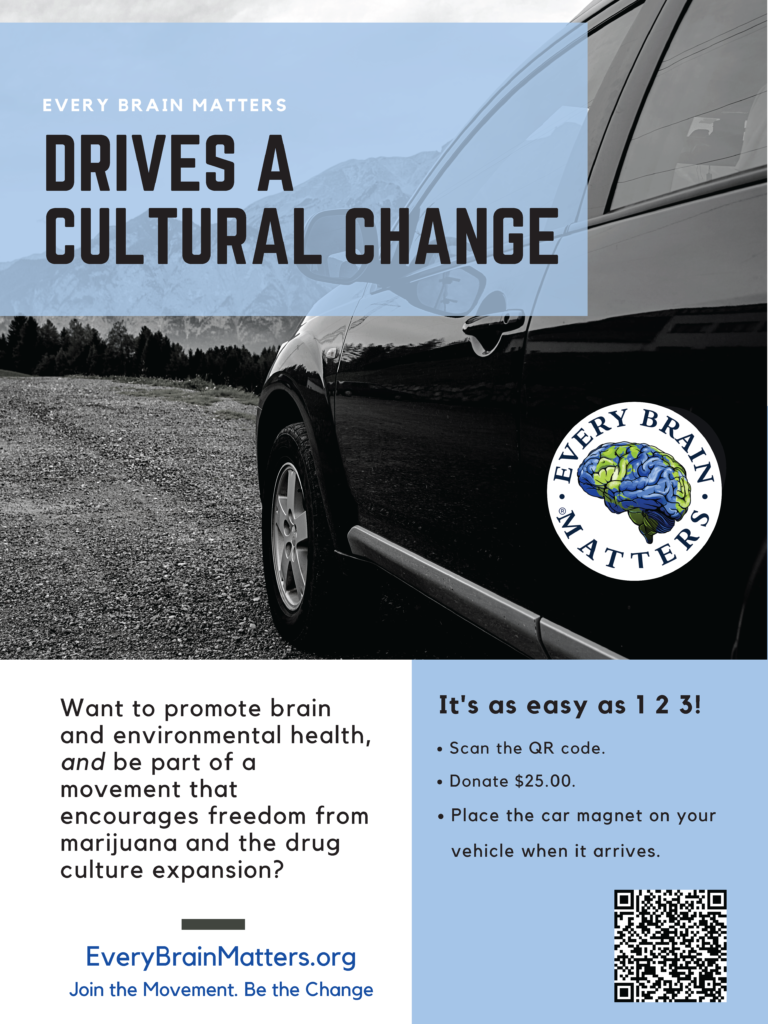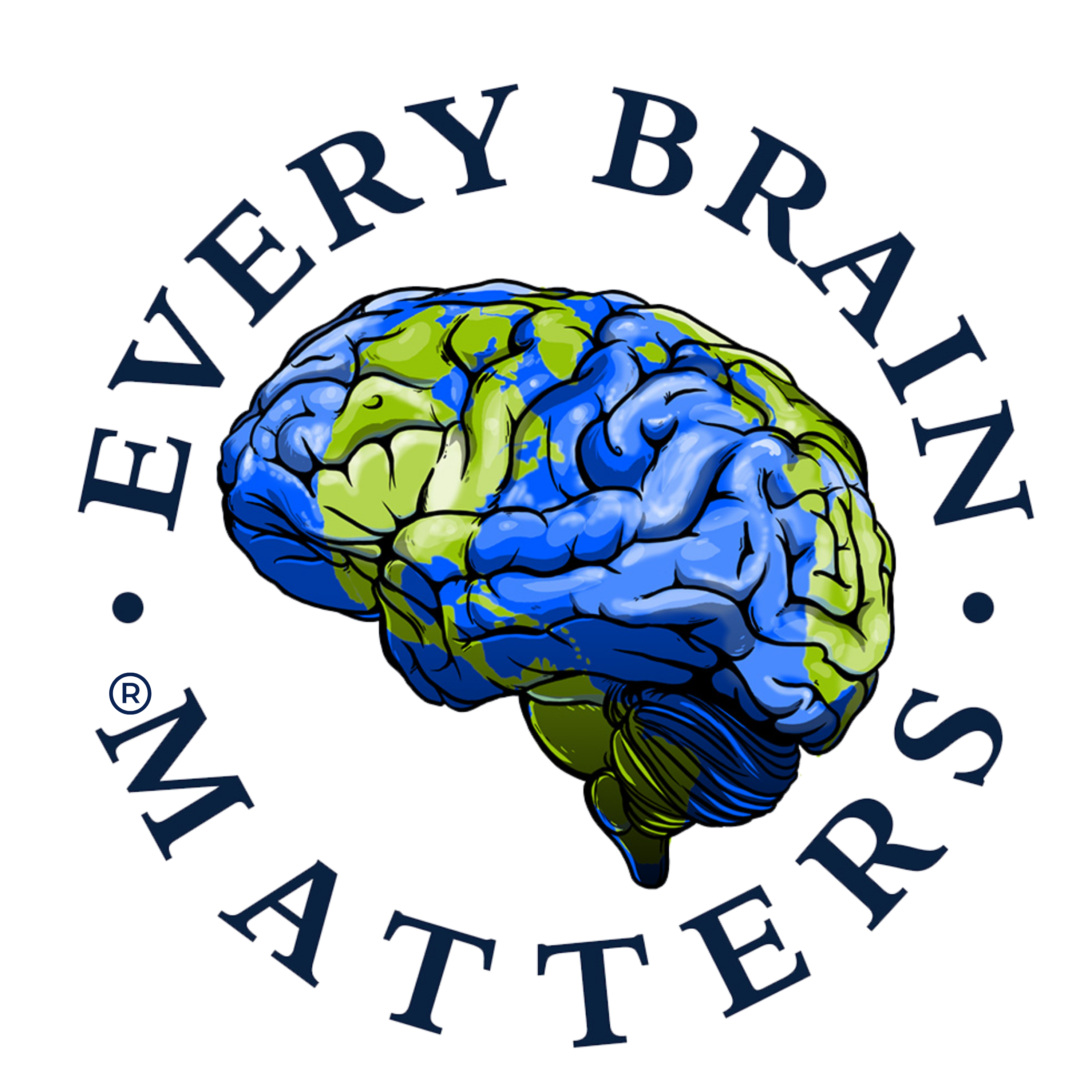Thank you for visiting this page. We recognize you are a person who wants to be part of improving the addiction and mental health crisis plaguing our country.
The Every Brain Matters community eases the solutions to finding freedom from marijuana and the drug culture expansion. It’s simple. Do these 2 steps.
1. Place this car magnet on your vehicle to make a public statement
2. Join the Every Brain Matters Community and Be Part of The Cultural Change
Scroll down to learn the science that connects the marijuana expansion to the opioid crisis and learn more about Michelle and Trevor and other families impacted by the marijuana to the fentanyl crisis.
Marijuana to Fentanyl, My Son is More Than a Statistic
by Michelle Leopold
When I discovered that my 14-year-old son Trevor was using cannabis regularly, I learned all I could about the new marijuana. I learned that the pot my friends smoked in college was maybe 2-4% THC, and 6% if you were lucky to score Maui Waui.
THC amounts in today’s medical marijuana strains average around 25%, with some award-winning strains up to 35% THC, and Dabs up to 99% THC. This is not hippie grass. Marijuana affects brain plasticity and proper neural function in youth.
Our family did all we could to stop our son’s addiction (a 14-year-old brain gets hooked quickly). We sent him to rehab, where he was diagnosed with Cannabis Use Disorder. He came home and within a year his addiction became a greater problem. I found multiple fake IDs and cannabis club memberships. When he was coming down from a high, our home, vehicles, and even myself became a punching bag for his drug-fueled rages. He ended up attending six high schools including three rehabs before graduating from High School in 2019. And yes, the day after his 18th birthday, his first legal medical marijuana card appeared in the mailbox, despite his long-standing issues with drugs.
My beautiful boy Trevor died in his dorm room at Sonoma State, after ingesting a Blue 30 street pill that was a lethal dose of 3 types of fentanyl. His unformed brain caused the neurons to search out a higher high after being introduced to cannabis at age 14.
Since his death, I have been an outspoken advocate against youth use of marijuana – particularly the facts which led to Trevor’s addiction and ultimate death.
• Potency: I encourage people to learn about the strength of today’s marijuana – it is not “just pot”.
• Biology: How the brain is not fully formed until age 25 in most young adults, and the likelihood for addiction increases to 1 in 6 for youth using marijuana when starting before the brain has reached adulthood.
• Gateway: Today’s marijuana leads many young people in search of a higher high.
• Suicide: How marijuana use in young adults increases suicide ideation seven-fold (additionally, toxicology results in suicides show a 10% increase in marijuana since legalization in CO.)
Is marijuana REALLY a safer alternative to prescription painkillers and the solution to the opioid epidemic? From the beginning, supporters of expanded cannabis legalization have promised that marijuana could save lives by replacing other, more dangerous drugs.
But like so many other claims about marijuana’s supposed benefits, that assertion doesn’t quite hold up. Despite that promise, legal medical and recreational marijuana play a significant role in the still-worsening opioid overdose crisis in America.
Let’s take a closer look at what science and statistics have to say.
WHAT ARE THE CLAIMS?
If you look at almost any pro-marijuana website, there will be statements about how cannabis is an effective treatment for “chronic pain“. Typically, rather than elaborating, these websites then quickly shift focus and talk about benefits other than pain reduction – relief from the nausea and vomiting associated with chemotherapy or the spasticity associated with multiple sclerosis, for example.
Some proponents cite small studies suggesting that patients who use medical marijuana are less likely to use opioid painkillers. Another study supposedly claims that one of the effects of marijuana dispensaries is a significant reduction in the number of opioid-related deaths. Finally, supporters claim that in places where cannabis becomes legal, admissions for opioid use disorder go down.
To get to the truth, we will examine each of these claims, one by one.
WHAT DOES THE FDA SAY?
Would it surprise you to learn that the Food and Drug Administration has not approved medical marijuana as an effective treatment for pain relief? Right off the bat, that weakens the strongest argument put forth by supporters of legalized marijuana expansion.
VAGUE WORDING
The imprecise use of the blanket term “chronic pain“ is misleading. There are many health conditions that can cause or contribute to long-term pain, and there is no magic one-size-fits-all remedy that is effective in all cases, including marijuana.
In fact, even when limited evidence is presented about the supposed pain-relieving benefits of marijuana, it only relates to specific conditions– neuropathic pain or pain due to rheumatic disorders, for example.
Sometimes, it is claimed that marijuana can treat “severe pain“, but that simply is not true. It is not at all effective at relieving the pain of a broken bone, post-surgical pain, or any other acute condition.
INCONCLUSIVE RESULTS
For every study suggesting that marijuana is a suitable pain medication, there is another larger study saying the opposite.
- 2017: A review of 27 published studies on marijuana and chronic pain found “low strength evidence“ that it relieves nerve pain but does not help with other kinds of persistent pain.
- 2019: Cannabis showed inconsistent results when treating the pain from rheumatic disorders and neuropathic pain, and was not effective at all at treating chronic cancer pain.
- 2021: A review of 32 clinical trials found that non-inhaled marijuana had little effect on chronic pain.
TEMPORARY BENEFITS
It is a fact that opioid-related emergencies do go down in areas where recreational marijuana was recently legalized.
But that positive effect is only temporary.
A 2021 study found that six months after legalization, the number of opioid injuries starts trending upward again, eventually reaching or even surpassing the previous totals.
DOES MARIJUANA USE LEAD TO OPIOID ABUSE?
Getting into the heart of the discussion that medical marijuana helps curb opioid abuse, a 2018 study published in the Journal of Addiction Medicine found that individuals who use medical marijuana have significantly higher rates of both medical and nonmedical use of prescription drugs – including opioid painkillers.
Compared to people who do not use medical marijuana, those that do are more than twice as likely to misuse prescription drugs such as tranquilizers, stimulants, and pain relievers.
A 2012 study by the Yale University School of Medicine found a link between cannabis use and prescription abuse, especially among young adults:
- Among men aged 18-25, the use of cigarettes, alcohol, or marijuana is associated with an elevated risk of medication misuse.
- Among women within that age group, however, only marijuana increases the risk of prescription abuse.
According to the Yale study, young adults who smoke weed are two-and-a-half times more likely to misuse prescription medications than their abstaining peers. This is significant, because 80% of heroin addicts started out by abusing prescription opioid painkillers.
Likewise, the National Institute on Drug Abuse reports that people who use marijuana are more than twice as likely to be dependent on or addicted to prescription opioids. They are also six times more likely to take pain pills:
- At higher-than-recommended dosages
- For longer periods of time
- For recreational purposes
- Without a prescription
A 2020 analysis of data from the National Survey on Drug Use and Health concluded that marijuana use as an adolescent is the most accurate predictor of Opioid Use Disorder in adulthood.
WORSENED CRAVINGS
Another argument used to promote cannabis legalization is the belief that people struggling with Opioid Use Disorder could potentially use marijuana to ease cravings and therefore, be better able to manage their addiction.
But the opposite seems to be true.
One of the biggest dangers of marijuana is how it triggers the use of other drugs. For anyone trying to recover from illicit heroin, prescription pain medications, or synthetic opioids like fentanyl, smoking pot can lead directly to a potentially-fatal relapse.
A study published earlier this year in Emerging Trends in Drugs, Addictions, and Health found that young people with OUD who attempted to use marijuana as a “safer” substitute for their chosen opioid were unsuccessful in their recovery.
Because smoking marijuana actually intensified their cravings for opioids, they were much more likely to relapse into active use.
Actual quotes from participants:
- “Weed was just not enough, and it accelerated my need for a heroin high.”
- “Smoking weed was like a little tickle, and started the cravings for heroin in motion.”
- “If I’m already getting high, I might as well get REALLY high, because opiates are better.”
- “Each time I relapsed on weed, I would immediately think heroin is so much better.”
Yet another study, published in Addiction in 2021 concluded that marijuana actually promotes the use of opioids instead of replacing them.
Study participants who abused opioids were monitored for 90 days. On the days when they smoked weed, the likelihood of them also misusing opioids almost doubled.
This happened even if they were not experiencing physical pain.
THE WORST PUBLIC HEALTH CRISIS IN AMERICA
If supporters were right, then as more states continue to decriminalize and legalize marijuana use, we should see a corresponding decrease in the number of fatal opioid overdoses.
But opioid deaths are continuing to climb at an alarming rate. According to the Centers for Disease Control and Prevention, there were over 100,000 drug overdose deaths in America during the 12-month period ending in April 2021, a 29% jump from the year before.
75% of those fatal overdoses involved opioids, especially powerful synthetics such as fentanyl and its chemical analogues. In fact, opioid-related deaths spiked 35% within that single year.
WHAT DO THE EXPERTS SAY?
Dr. Coleman Drake, Assistant Professor of Health Policy and Management at the University of Pittsburgh, says, “Maybe for those who already have Opioid Use Disorder, they’re finding that cannabis is not sufficient to treat all the symptoms of their condition.”
He continues, “There might be a substitution back towards (heroin, fentanyl, or other opioids) after a period of time.”
Dr. Jodi Gilman, with the Center for Addiction Medicine at Massachusetts General Hospital, says, “There have been many claims about the benefits of medical marijuana for treating pain, insomnia, anxiety, and depression, without sound scientific evidence to support them.”
Dr. Kevin Sabet, formerly the Senior Drug Policy Advisor for the Obama administration and currently the President of Smart Approaches to Marijuana, says this type of scientific research “undercuts the argument that marijuana can be a form of substitute for those suffering from opioid addiction.”
Dr. Sabet continues, saying, “We must not allow industry rhetoric to supersede the preponderance of data we have showing marijuana can potentially exacerbate the addiction crisis our country is suffering.”
THE BOTTOM LINE ABOUT MARIJUANA AND THE OPIOID EPIDEMIC
Since 1999, drug overdoses have killed over a million people in this country. To put that in perspective, that is more lives lost than in every battle since World War I combined.
That’s right – drugs have killed more Americans than war.
The overdose crisis is fueled by the opioid epidemic – heroin, prescription painkillers, and now, illicitly-made fentanyl, a drug so powerful that a dose as small as six grains of salt can be fatal. Fentanyl has killed so many people that the CDC now calls it the “deadliest drug in America.”
People who support expanded legalization are quick to point out that “no one has ever fatally overdosed on marijuana”, as if that somehow makes the drug harmless and safe to use.
But marijuana kills in other ways.
Headlines and news stories still mention the ongoing opioid epidemic and how it all started – dishonest and greedy pharmaceutical companies, overprescribing doctors, and shady pill mills.
What has gone woefully unreported, however, is the role that marijuana continues to play as a gateway drug that leads too many people to the harder substances that can ruin and even take their lives.
In other words, the overdose crisis and the opioid epidemic and marijuana expansion are not separate issues. They are all part of a vicious and deadly cycle that affects millions of people.
As a country, we all need to urgently realize that while the overdose crisis is being fueled by the opioid epidemic, that epidemic is in large part fueled by unprecedented marijuana availability and use.
Only then can we take the proper steps needed to break the cycle and save lives.
Every Brain Matters memorializes the lives that we lost due to the marijuana to opioid connection and shares their stories to raise awareness in response to the growing addiction and mental health crisis.
Every Brain Matters is a community of support, advocacy, and science that calls for a cultural change by encouraging the use of the EBM merchandise. Our logo symbolizes “freedom from marijuana and the drug culture expansion.
SOURCES
Legal weed was supposed to help ease the opioid crisis. What happened? (yahoo.com)
US overdose deaths hit record 93,000 in pandemic last year (yahoo.com)
Overdose Deaths Increased by Nearly 30% in 2020 (healthline.com)
https://pubmed.ncbi.nlm.nih.gov/29637590/
https://www.ncbi.nlm.nih.gov/books/NBK574562/
https://www.menshealth.com/health/a19530220/marijuana-ineffective-for-pain/
https://www.sciencedaily.com/releases/2018/04/180417181122.htm
Science proves marijuana’s path to opioids…
Early initiation of marijuana is a dominant predictor of Opioid Use Disorder.
Medical marijuana states have seen a 23% increase in opioid overdose deaths.
When marijuana can no longer excite the common pathway as the drug’s receptors become desensitized, the user switches to a new drug. The addiction to marijuana is no longer satisfying.
Research has confirmed that marijuana acts as a gateway drug for many users:https://www.ncbi.nlm.nih.gov/pmc/articles/PMC3552239/pdf/nihms388189.pdf
https://www.ncbi.nlm.nih.gov/pmc/articles/PMC4291295/pdf/nihms-618789.pdf
https://www.ncbi.nlm.nih.gov/pmc/articles/PMC5537531/pdf/jech-2016-208503.pdf
MATHEMATICS PROVES CORRELATION TO MARIJUANA AS GATEWAY DRUG
-25-year Christchurch Longitudinal Study demonstrated that in 86% of cases of those who had taken two or more illegal drugs, marijuana had been the drug the study subjects had taken first.
Adolescents’ initial use of marijuana and inhalants may lead to substantial risks of using other drugs over time.



